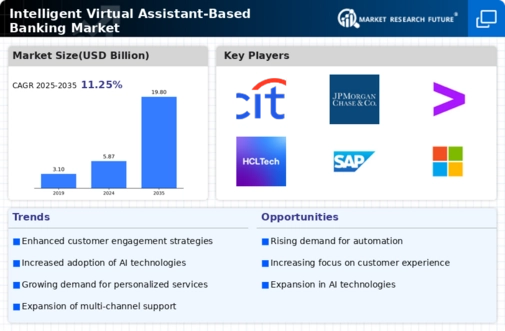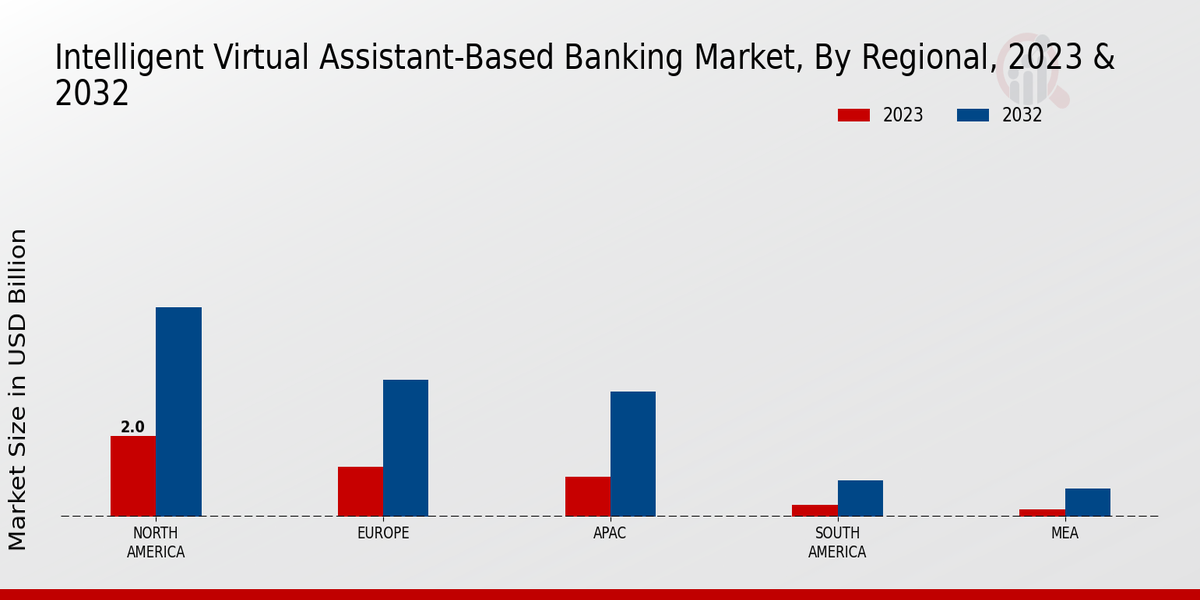Cost Efficiency and Operational Optimization
Cost efficiency emerges as a critical driver within the Global Intelligent Virtual Assistant-Based Banking Market Industry. By automating routine tasks such as account inquiries and transaction processing, banks can significantly reduce operational costs. The deployment of intelligent virtual assistants allows financial institutions to allocate resources more effectively, leading to improved productivity. This trend is particularly relevant as banks seek to navigate economic pressures while maintaining service quality. The anticipated growth of the market to 19.8 USD Billion by 2035 further emphasizes the financial benefits associated with adopting these technologies, suggesting a long-term commitment to operational optimization.
Growing Adoption of Mobile Banking Solutions
The proliferation of mobile banking solutions significantly influences the Global Intelligent Virtual Assistant-Based Banking Market Industry. As consumers increasingly rely on mobile devices for financial transactions, banks are compelled to enhance their digital offerings. Intelligent virtual assistants serve as a crucial component of mobile banking applications, providing users with instant access to account information and transaction capabilities. This trend aligns with the broader shift towards digital banking, where convenience and accessibility are paramount. The market's anticipated growth trajectory, reaching 19.8 USD Billion by 2035, underscores the importance of mobile integration in driving the adoption of virtual assistants.
Rising Demand for Enhanced Customer Experience
The Global Intelligent Virtual Assistant-Based Banking Market Industry experiences a surge in demand for enhanced customer experience. Financial institutions increasingly recognize the necessity of providing seamless, personalized services to retain customers. Intelligent virtual assistants, equipped with AI capabilities, facilitate 24/7 customer support, addressing inquiries and processing transactions efficiently. This trend is underscored by the projected market value of 5.87 USD Billion in 2024, indicating a robust growth trajectory. As banks strive to differentiate themselves in a competitive landscape, the integration of virtual assistants becomes pivotal in enhancing customer satisfaction and loyalty.
Regulatory Compliance and Security Enhancements
Regulatory compliance and security considerations are paramount in the Global Intelligent Virtual Assistant-Based Banking Market Industry. Financial institutions face increasing scrutiny regarding data protection and privacy regulations. Intelligent virtual assistants can assist in ensuring compliance by automating reporting processes and monitoring transactions for suspicious activities. Moreover, these technologies can enhance security measures through biometric authentication and fraud detection capabilities. As banks prioritize regulatory adherence and customer trust, the integration of virtual assistants becomes essential. The market's growth, projected at 5.87 USD Billion in 2024, reflects the industry's commitment to addressing these critical challenges.
Advancements in AI and Natural Language Processing
Technological advancements in artificial intelligence and natural language processing are pivotal to the Global Intelligent Virtual Assistant-Based Banking Market Industry. These innovations enable virtual assistants to understand and respond to customer inquiries with remarkable accuracy and context awareness. As AI capabilities evolve, banks can offer more sophisticated interactions, enhancing user engagement. The integration of these technologies not only improves customer satisfaction but also drives operational efficiency. With a projected compound annual growth rate of 11.67% from 2025 to 2035, the market is poised for substantial growth, reflecting the increasing reliance on advanced AI solutions in banking.


























Leave a Comment